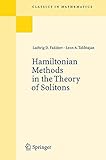Hamiltonian Methods in the Theory of Solitons [electronic resource] / by Ludwig D. Faddeev, Leon A. Takhtajan.
Material type: TextSeries: Classics in MathematicsPublisher: Berlin, Heidelberg : Springer Berlin Heidelberg : Imprint: Springer, 2007Description: IX, 594 p. 8 illus. online resourceContent type:
TextSeries: Classics in MathematicsPublisher: Berlin, Heidelberg : Springer Berlin Heidelberg : Imprint: Springer, 2007Description: IX, 594 p. 8 illus. online resourceContent type: - text
- computer
- online resource
- 9783540699699
- 530.1 23
- QC19.2-20.85
The Nonlinear Schrödinger Equation (NS Model) -- Zero Curvature Representation -- The Riemann Problem -- The Hamiltonian Formulation -- General Theory of Integrable Evolution Equations -- Basic Examples and Their General Properties -- Fundamental Continuous Models -- Fundamental Models on the Lattice -- Lie-Algebraic Approach to the Classification and Analysis of Integrable Models -- Conclusion -- Conclusion.
The main characteristic of this now classic exposition of the inverse scattering method and its applications to soliton theory is its consistent Hamiltonian approach to the theory. The nonlinear Schrödinger equation, rather than the (more usual) KdV equation, is considered as a main example. The investigation of this equation forms the first part of the book. The second part is devoted to such fundamental models as the sine-Gordon equation, Heisenberg equation, Toda lattice, etc, the classification of integrable models and the methods for constructing their solutions.
There are no comments on this title.



























